This article has been reviewed according to Science X’s editorial process and policies. Editors have highlighted the following attributes while ensuring the content’s credibility:fact-checkedreputable news agencyproofread

Mastodon bones are displayed at the Grand Rapids Public Museum on Thursday, May 18, 2023, in Grand Rapids, Mich. The bones are part of an exhibit and were unearthed last year during a drainage dig in western Michigan and belonged to a juvenile mastodon that lived 13,000 years ago. Credit: AP Photo/Mike Householder
“Anything over 20 you’re super excited about, so 75 to 80% is absolutely fantastic,” Redman said.Unfortunately, no tusks were found and only a partial skull, which is displayed under glass near a large photo of the excavation site. The skeleton was discovered last August on private property belonging to the Clapp family, who decided to donate it to the museum.

Local and county officials hold mastodon bones at the Grand Rapids Public Museum on Thursday, May 18, 2023, in Grand Rapids, Mich. Some of the mastodon bones, found last summer in Newaygo County, will be unveiled as part of museum’s “Ice Age: Michigan’s Frozen Secrets” exhibit, which opens to the public on May 20. Credit: Cory Morse/MLive.com/The Grand Rapids Press via AP
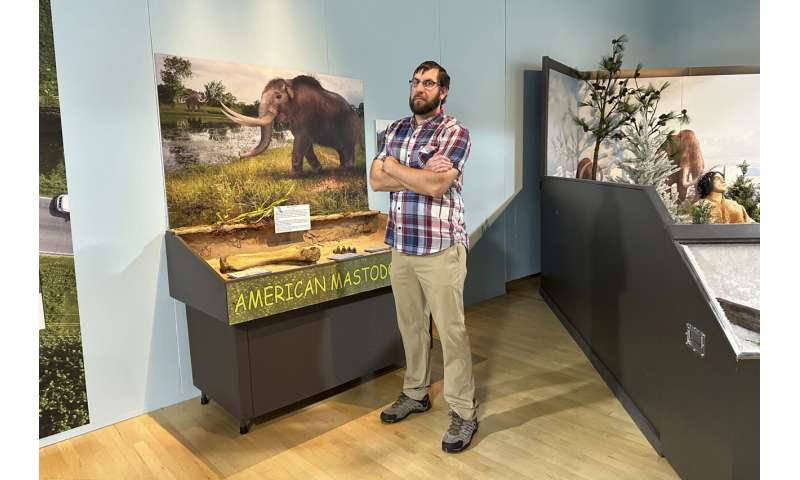
Cory Redman, science curator at the Grand Rapids Public Museum, stands near a mastodon display at the museum on Thursday, May 18, 2023, in Grand Rapids, Mich. Mastodon bones being shown at GRPM were unearthed last year during a drainage dig in western Michigan and belonged to a juvenile mastodon that lived 13,000 years ago. Credit: AP Photo/Mike Householder
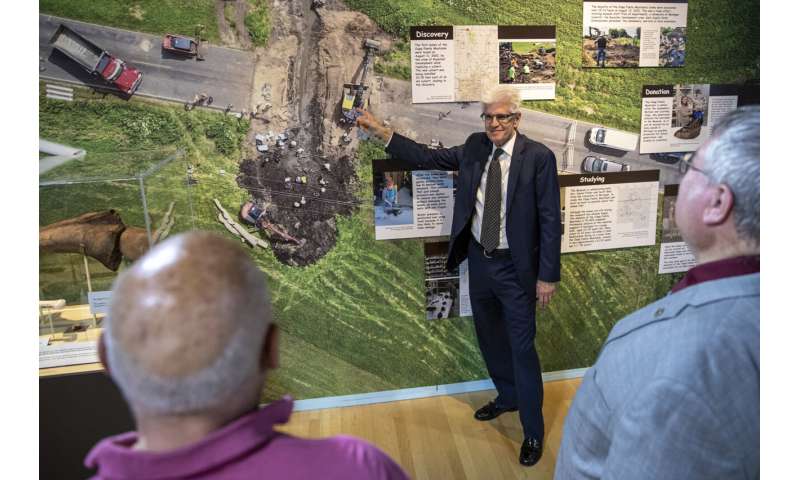
Grand Rapids Public Museum president and CEO Dale Robertson talks about mastodon bones found last summer in Newaygo County at the museum on Thursday, May 18, 2023, in Grand Rapids, Mich. Some of the mastodon bones will be unveiled as part of museum’s “Ice Age: Michigan’s Frozen Secrets” exhibit, which opens to the public on May 20. Credit: Cory Morse/MLive.com/The Grand Rapids Press via AP
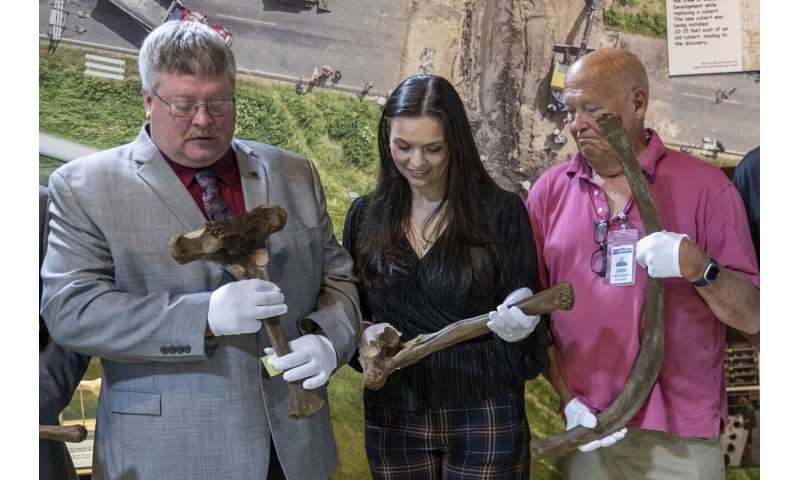
Bryan Kolk, from left, Chair of the Newaygo County Board of Commissioners, Jenn Merchant, Kent County Commissioner, and Dale Twing, Newaygo County Drain Commissioner, hold mastodon bones at the Grand Rapids Public Museum on Thursday, May 18, 2023, in Grand Rapids, Mich. Some of the mastodon bones, found last summer in Newaygo County, will be unveiled as part of museum’s “Ice Age: Michigan’s Frozen Secrets” exhibit, which opens to the public on May 20. Credit: Cory Morse/MLive.com/The Grand Rapids Press via AP
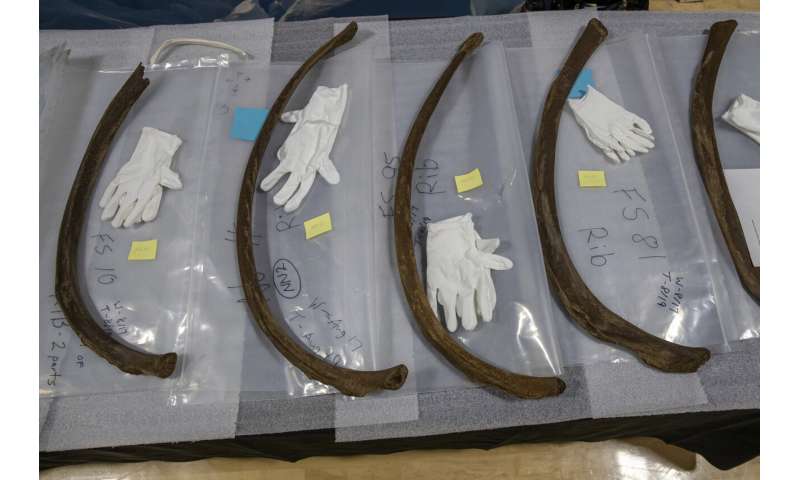
Mastodon bones are displayed at the Grand Rapids Public Museum on Thursday, May 18, 2023, in Grand Rapids, Mich. Some of the mastodon bones, found last summer in Newaygo County, will be unveiled as part of museum’s “Ice Age: Michigan’s Frozen Secrets” exhibit, which opens to the public on May 20. Credit: Cory Morse/MLive.com/The Grand Rapids Press via AP
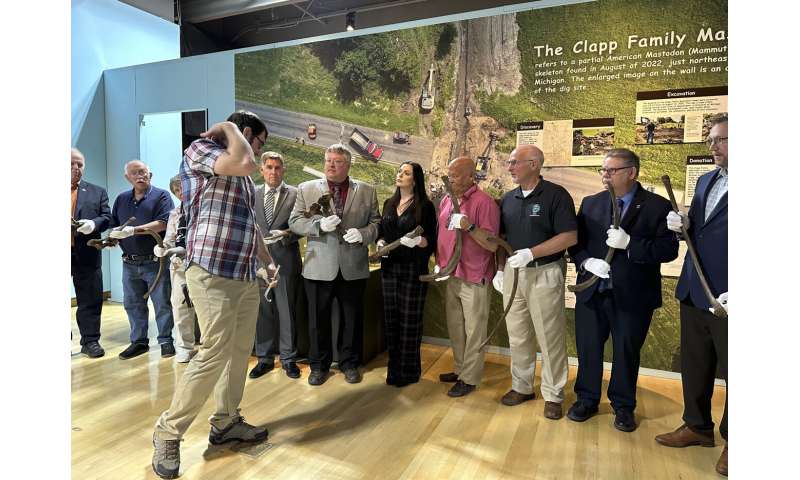
Cory Redman, foreground, science curator at the Grand Rapids Public Museum, discusses the anatomy of a mastodon while speaking with officials at the museum on Thursday, May 18, 2023, in Grand Rapids, Mich. Mastodon bones on display at GRPM were unearthed last year during a drainage dig in western Michigan and belonged to a juvenile mastodon that lived 13,000 years ago. Credit: AP Photo/Mike Householder

Local and county officials hold mastodon bones at the Grand Rapids Public Museum on Thursday, May 18, 2023, in Grand Rapids, Mich. Some of the mastodon bones, found last summer in Newaygo County, will be unveiled as part of museum’s “Ice Age: Michigan’s Frozen Secrets” exhibit, which opens to the public on May 20. Credit: Cory Morse/MLive.com/The Grand Rapids Press via AP

Cory Redman, science curator at the Grand Rapids Public Museum, stands near a mastodon display at the museum on Thursday, May 18, 2023, in Grand Rapids, Mich. Mastodon bones being shown at GRPM were unearthed last year during a drainage dig in western Michigan and belonged to a juvenile mastodon that lived 13,000 years ago.
The exhibit also features an array of creatures from the Pleistocene period. The museum acquired 63 new fossils and casts, allowing visitors to touch real fossilized bones and teeth.But the Clapp Family Mastodon is the star of the show.The juvenile was between 10 and 20 years old when it died, said Redman, which radiocarbon dating puts at around 13,210 years ago.
“What makes this specimen unique and so exciting is it’s a juvenile. It’s a young animal. Typically, when you find them, they’re adults. And also, the degree of completeness,” Redman said.
This document is subject to copyright. Apart from any fair dealing for the purpose of private study or research, no part may be reproduced without the written permission. The content is provided for information purposes only.